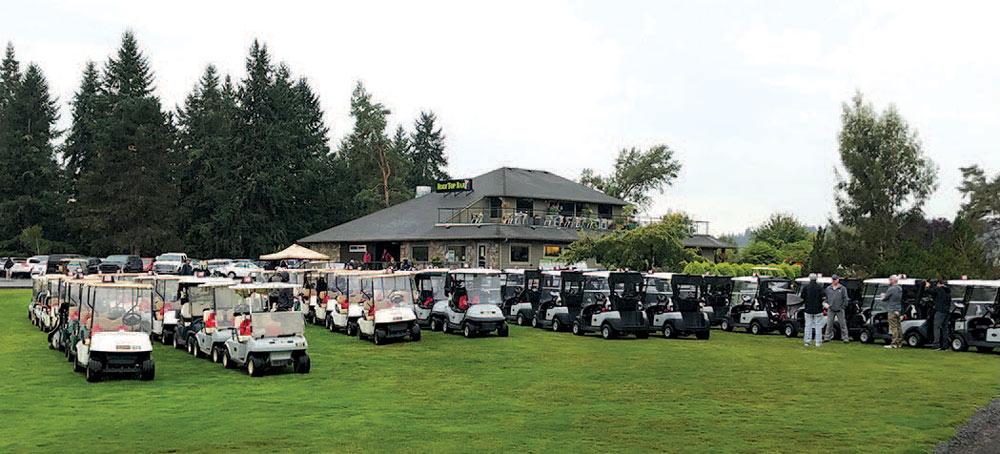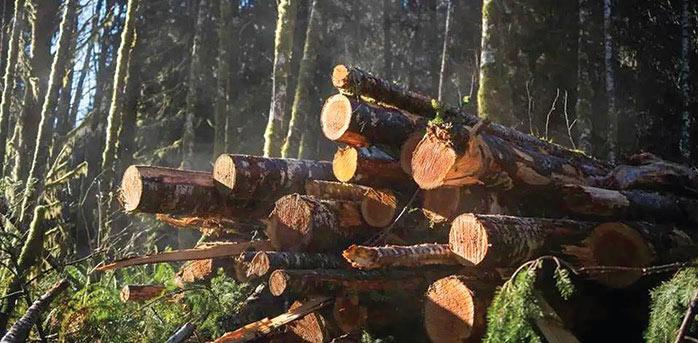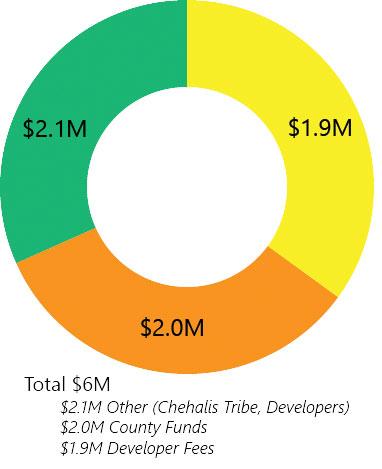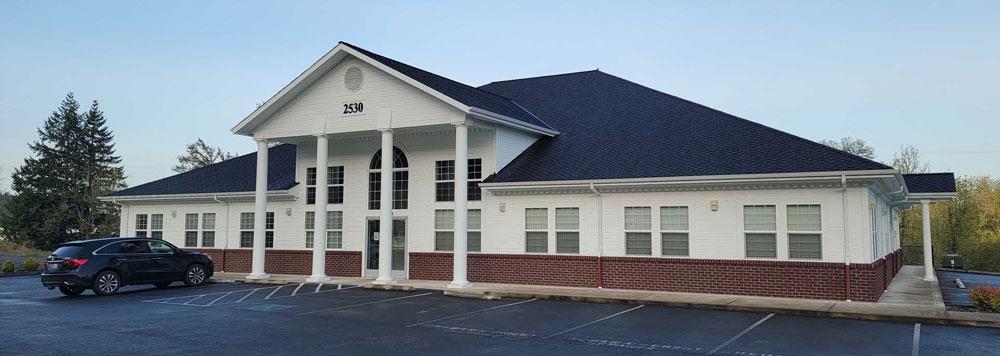Golf carts line up last year at the inaugural Economic Alliance of Lewis County Open Golf Tournament. This year features a Skills Competition Night this Thursday, with the sold-out tournament this Friday.
Economic Alliance Features Golf Skills Contest
The Evening Before Big Tournament Showcases Long Drives, Chipping and Putting Competitions
By the Economic Alliance of Lewis County
The eve of the second-annual Economic Alliance of Lewis County Open Golf Tournament at Riverside Golf Course will feature a Skills Competition Night at 5:30 p.m., this Thursday, Sept. 15.
The tournament on this Friday, Sept. 16, is sponsored by Fortescue Future Industries North America and is already full but still accepting teams on a waiting list. The Skills Competition Night, however, is open to anybody willing to put their golf talents up for prizes and enjoy an overall great time.
Sponsored by Nomad Truck and SUV Outfitters and LC Coffee Company, skills events will be Longest Drive, Chipping Contest and Putting Course, with $1,000s in prizes. Cost to enter is $100 for all three competitions or $50 per category. Entry includes two raffle tickets and one drink ticket.
Music, appetizers and two no-host bars will keep competitors swinging easy. One top raffle ticket is an overnight stay at the Ridgefield Ilani Casino in their new hotel, and dinner for two at the casino’s exclusive Michael Jordan’s Steak House.
Come on out and show off your golfing skills while also supporting your Economic Alliance of Lewis County. To pre-register call 360.748.0114 or you can register at the event.
Lumber Prices Soar, Then Abruptly Fade
‘I Hesitate To Say It Was a Windfall for Anybody’ By Mike Rogoway oregonlive.comForest products companies have endured a wild stretch over the past two years, with lumber prices quintupling during the pandemic and then fading back to something close to normal.
The extreme price swings are another sign of the supply chain chaos and economic upheaval that accompanied COVID-19.
Soaring lumber prices were a harbinger of coming inflation when they began their steep upward climb two years ago. Now, a rapid fall could help moderate historic inflation in other sectors that use lumber.
Lumber prices soared from around $300 per 1,000 board feet of lumber in the weeks before the pandemic hit in 2020 to more than $1,600 in the spring of 2021.
Demand also soared in 2020 amid an uptick in homebuilding — an industry that wasn’t disrupted by COVID-19 health restrictions — and a surge in home-improvement projects by do-it-yourselfers. People across the country were cooped up at home with fewer alternatives for spending their wages and pandemic relief payments.
At the same time, the lumber supply was disrupted by a shortage of truck drivers and millworkers. The resulting squeeze pushed prices to astronomical levels.
“Prices skyrocketed from what was actually a pretty stable trend for de-cades,” said Brandon Kaetzel, principal economist at the Oregon Department of Forestry.
Prices then went into steep decline as producers unsnarled their supply chains and rising interest rates cut into home sales. That, in turn, reduced home construction and lumber de-mand.
It’s great for lumber producers when prices rise, but the upside was short-lived before prices abruptly fell back to earth. Current prices are around $500 per 1,000 board feet, up only modestly from right before the pandemic — and down slightly from 2018 and 2019.
Some companies couldn’t meet peak demand during the pandemic because of their own labor or supply constraints. Others, Kaetzel said, took advantage of the brief surge to invest in mill upgrades.
“I’d hesitate to say it was a windfall for anybody,” he said.
Not among independent mills, anyway. Boise Cascade shares are up more than 40% over the past two years, climbing twice as fast as the broader stock market.
And higher prices have been good for the counties that receive state tim-ber revenue, according to a spokes-person for the state agency. Stumpage prices — the price timber companies pay for the right to harvest trees — re-mains up about 25% from last year.
“There’s a real public benefit there when those timber prices are higher. Because that translates to higher rev-enue to counties on the same (amount) of timber,” the spokesperson said. “We’re in a better position to take on proactive projects on things like forest health, conservation.”
Gas Prices Continue to Drop Nationwide
You Can Find Gas as Cheap as $4.32 in Downtown Centralia By the Economic Alliance of Lewis CountyFor the twelfth consecutive week, the nation’s average gas price has fallen, declining 7.7 cents from a week ago to $3.75 per gallon today, according to GasBuddy data compiled from more than 11 million individual price reports covering over 150,000 stations nationwide.
Locally, as of yesterday (Friday) gas prices averaged $4.86 across Lewis County. For the best deal, as of yesterday in Centralia, you can find gas as cheap as $4.32 at the Harrison Super Mart, and $4.33 at both the ARCO and Safeway in Centralia (to find the cheapest gas in your area go to gasbuddy.com).
The national average is down 29.5 cents from a month ago but 57.6 cents higher than a year ago. The national average price of diesel has declined 2.0 cents in the last week and stands at $5.02 per gallon.
“The national average has declined for 12 straight weeks, the longest tally since 2018, and it could soon eclipse that mark if we see two more weeks of decline. Though, that may be more challenging given OPEC’s decision yesterday to cut oil production,” said Patrick De Haan, head of petroleum analysis at GasBuddy. “For now, price movements will be contingent on where you are, with California seeing some minor increases, while the Great Lakes could see an upward move as BP’s refinery outage has had an impact on supplies. In the Gulf and Rockies, prices may continue to fall, so a very mixed bag for motorists in the week ahead. In addition, there are several disturbances in the Atlantic to keep an eye on, but we do switch back to cheaper winter gasoline in just over a week which should provide some additional relief.”
The median U.S. gas price is $3.59 per gallon, down 6 cents from last week and about 16 cents lower than the national average.
The top 10% of stations in the country average $5.13 per gallon, while the bottom 10% average $3.07 per gallon.
The states with the lowest average prices: Texas ($3.22), Arkansas ($3.22) and Mississippi ($3.25).
The states with the highest average prices: Hawaii ($5.21), California ($5.21) and Nevada ($4.81).
MEMBER SPOTLIGHT
Fuller Designs Brings Big Project Experience to Lewis County
Storage Project Will Inject an Estimated $18 Million into the Local Economy Over the Next Nine Years
By the Economic Alliance of Lewis County
Lewis County has a long-time heritage of farming and agriculture, with some farmers being the third or fourth generation to grow in Lewis County. For many years, these local farmers and growers have dealt with flooding and natural disasters, loss of processing facilities, and a lack of infrastructure to support agribusiness.
In response to these issues, regional producers formed the Southwest Washington Growers Cooperative to support agricultural development in Southwest Washington. Today, the Cooperative has 31 active members seeking to increase the viability of family farms through collaborative opportunities. These producers worked closely with Northwest Agriculture Business Center (NABC) and WSU Extension and found that grain, especially malting barley, could serve as a viable crop replacement for both growers and buyers. However, infrastructure was still needed to provide storage and facilitate transporting crops to regional buyers, most of whom require rail transport.
In 2019, the Port of Chehalis and the Cooperative successfully petitioned the Lewis County Commissioners and were awarded $800,000 for the installment of a rail spur on the Port’s property. The rail spur was completed in the spring of 2020 and allowed growers to transload malting barley to Great Western Malting in Vancouver, Washington, that summer.
The first year saw 600 metric tons of barley delivered, followed by 1,400 metric tons in 2021. It’s projected that 2,500 metric tons will be delivered in 2022, produced on approximately 1,000 acres.
The next phase of the Southwest Washington Grain Project began shortly after the completion of the rail spur, with the goal of creating an aggregate storage and rail transload facility alongside the rail spur.
In support of this goal, the Port of Chehalis was awarded $1.75 million through the Washington state Capital Budget in 2020. This funding will allow for the construction of a publicly accessible rail transload facility consisting of upright grain bins and conveyors for loading and unloading grain.
The Port of Chehalis is actively pursuing additional funding for the design and construction cost associated with the installation of roads and utilities to serve the facility. If the necessary remaining funding is secured, construction could begin sometime in 2023.
Once completed, the storage and transload facility will allow the region’s grain producers to access regional, national and international markets. The project anticipates generating over $750,000 in producer payments and handling fees in 2022 and injecting an estimated $18 million into the local economy over the next nine years.
— Source: POC Media
Construction Starts Soon at US 12 in Grand Mound
By the Economic Alliance of Lewis County
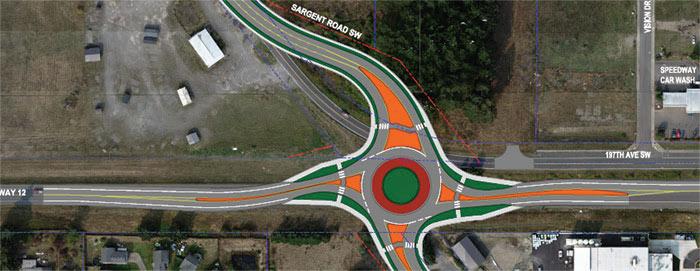
A contractor is scheduled to start the end of September on a roundabout to create a new intersection at US Highway 12 and Sargent Road SW in Grand Mound. Construction will continue into next year and is expected to finish by fall 2023.
Two-way traffic will be maintained on US 12 throughout construction. Drivers can expect delays due to reduced speed limits in construction zones. Work is planned to take place from 7 a.m. to 6 p.m. Monday through Friday. As work is weather dependent and other issues may arise, this schedule is subject to change.
US 12 is a major east-west highway that runs through southwest Thurston County. Travelers use this route to connect to Interstate 5 and Grays Harbor County to the west. US 12 connects to State Route 510 east of I-5 which is another vital highway carrying traffic to and from communities including Tenino, Bucoda and Rainier. Grand Mound’s businesses and residences use US 12 daily to connect to I-5 and surrounding areas.
Increased development around this urban growth area is expected in the coming years. The completion of this roundabout adds an additional north south crossing of US 12 improving traffic flow for current and planned developments. Additional route options improve emergency response. This single-lane roundabout is designed to expand to a four-lane highway on US 12 in the future.
Roundabouts have been found to reduce the severity of accidents while keeping traffic moving. Studies show that roundabouts provide:
- A 37% reduction in overall collisions
- A 75% reduction in injury collisions
- A 90% reduction in fatality collisions
- A 40% reduction in pedestrian collisions
Development in Grand Mound provides services such as banks, restaurants and retail outlets which benefit residents. Local developers and the Confederated Tribes of the Chehalis Reservation have contributed funds for the construction of this project.


Feel-Good End of Summer Events Signal a More Back-To-Normal Existence
Southwest Washington Fair, Garlic Fest Enjoy Great Attendance By Ben Kostick Chairman – Economic Alliance of Lewis County
Late summer in Lewis County finally started to feel a bit more normal around here as the Southwest Washington Fair capped off a summer of parades, festivals and gatherings.
While the pandemic is still somewhat active (watch out for Monkeypox!), it sure feels like we have emerged from all those interesting early days of wearing masks, six-feet distancing, closed restaurants and the like.
As detailed in this month’s Economic Report, gas prices are dropping, lumber prices have dropped and it appears the real estate market is settling down and getting back to more normal.
It also appears that this weekend and through Thursday we will enjoy a last gasp of warm and sunny weather along with back-to-school which also typically signals a back-to-work season after summer vacations, camping outings and family barbecues.
The Southwest Washington Fair
As part of turning the corner on Covid, attendance at the fair was back to more normal numbers. An estimated 71,000 people went through the gates at the six-day fair, up from last year. The National Professional Rodeo Association/Pro-West sanctioned rodeo was a near sell-out with about 3,000 in attendance.
Vendors reported an increase in sales of more than 33% from last year. According to county officials, one vendor said it was the best year for sales in the 32 years they have been coming to the fair.
The great attendance continued at the Washington State Garlic Festival which took place at the fairgrounds the last weekend in August. The Saturday of the festival was jam packed.
Junior Livestock
Another impressive aspect of the fair was the Junior Livestock Market Sale with participation by the Lewis County 4-H and FFA youth. The sales brought in more than $620,000 for the 203 livestock put up for auction by 167 youth, rewarding all that hard work that the outstanding youth did in raising and grooming their livestock.
WSU Lewis County Extension 4-H Youth Development Director Pam Watson called the money raised “huge,” adding, “a majority of the money raised goes directly to youth.”
Kudos to those who helped organize and run the livestock sales.
Skills Competition
One last note on-end-of-summer fun.
This week, specifically Thursday and Friday, the Economic Alliance of Lewis County is putting on its second annual Open Golf Tournament at Riverside Skills Competition Night at 5:30 p.m.
this Thursday, Sept. 15 (unfortunately
the Friday golf tournament is sold out).
The Skills Competition is open to all.
Just show up Thursday afternoon and
win $1,000s of dollars in prizes with
competition in longest drive, chipping
and putting. Adding to the fun on
Thursday will be music, appetizers and
two no-host bars. Don’t miss out on the
opportunity to win one of the top raffles
— an overnight stay at the Ridgefield
Ilani Casino in their new hotel, and
dinner for two at the casino’s exclusive
Michael Jordan’s Steak House.
Enjoy what appears to be the last
week of summer weather this week.
•••
Ben Kostick is chair of the Economic Alliance of Lewis County and owner of Ben M. Kostick CPA Inc.

Jereme Chapman
KPFF Consulting Engineers
Jereme Chapman – Business: KPFF Consulting Engineers
Q: How long have you been a member of the Economic Alliance of Lewis County?
A: A member for 6 years, and a Board Member for 10 Months.
Q: Why did you join The Alliance?
A: The Alliance is a great organization that focuses on something that impacts us all daily, the economy. Who wouldn’t want to be a part of that and contribute a little of our time, for a large impact on our community?
Q: What is a key for the success of your business?
A: Relationships. You cannot put enough emphasis on building solid relationships with the people you work with inside and outside your organization.
Q: What do you enjoy most about volunteering?
A: The pay!
Q: What do you love most about your industry?
A: I enjoy that each project presents a unique set of challenges and solutions.
Q: How do you define success?
A: There are so many different versions of success depending on what aspect of life you are talking about. A broad definition to me is that whatever I am involved in, that I leave it better off than I found it.
Q: Who inspires you?
A: People who come from nothing, have a hard life, and rise above everything to become a success.
Q: What is one thing, either industry-related or not, you learned in the last month?
A: My golf game does not get better by not playing.
Q: What’s the last book you read?
A: Humanocracy by Gary Hamel. It explores businesses that operate with a flat structure and contrasts them with businesses that are mired in bureaucracy with layers of middle management and the efficiency with which they both operate.
Q: What is your favorite meal?
A: Any meal I get to sit down with the entire family and eat, that’s my favorite.
Q: What do you do for pleasure outside of running your business?
A: Hunting, golfing and fishing are my main hobbies outside of enjoying my kids’ sporting events.
Q: What is the favorite car you have ever owned?
A: I’ve never really thought of vehicles like that, more of a tool to get me to where I need to be.
Q: What is something about you (a fun fact) that not many people know?
A: At one point I did ballistic testing and long range shooting demonstrations for an ammunition company for sales to foreign military suppliers.

SPONSORED CONTENT
Thurston-Lewis-Mason Central Labor Council
Scot Industries Joins Growing Apprenticeship Wave
Lewis County Poised to Be a Regional ‘Hydrogen Hub’
BY THE WASHINGTON STATE LABOR COUNCIL, AFL-CIO
Scot Industries Inc., has launched a registered apprenticeship program in Lewis County that will keep the firm on the cutting edge of production and innovation.
It’s one of many companies statewide that are taking up the apprenticeship advantage. In fact, the number of people and companies participating in registered apprenticeships reached an all-time high just late last year.
“Apprenticeship programs are thriving across the state,” said Jody Robbins, Apprenticeship Program manager for the Washington State Department of Labor & Industries. “We’re encouraged to see a growing number of employers, educators, and other workforce partners get involved.”
The quickest way for an individual or company to find out about registered apprenticeships is to go to www.Lni. wa.gov/Apprenticeship.
What Scot Industries is Doing
Scot Industries, located in Centralia, is a supplier of specialty tubing product. It recently started the apprenticeship for Computer Numerically Controlled (CNC) Machinists. CNC Machinists are key in moving forward in the manufacturing and precision process the company uses.
The registered apprenticeship is an intensive effort to recruit employees. Apprentices obtain hands-on training and classroom education while receiving competitive pay in a growing industry.
The company was founded in 1949. The 73,000-square-foot Centralia plant was completed in 2007.
About Apprenticeship
Last year, there were about 21,700 active apprentices in the state – ranking the state ninth nationally. There are more than 5,000 participating employers covering more than 400 different occupations.
In fact, the total number of participants would make registered apprenticeship programs the third largest “school” in the state. It would be placed behind only the University of Washington and Washington State University.
Construction trades such as carpenter, ironworker, and electrician remain at the top of the training list. But apprenticeship is expanding into high tech, health care, and other fields.
“Employers need a reliable talent pipeline and workers need pathways into rewarding careers,” Robbins said. “Registered apprenticeship programs provide an opportunity for employers and workers, boosting our entire economy.”
For registered apprentices who become journey-level workers, the results are very real. Six to nine months after completion of a program, an apprentice in the trades can earn more than $85,000 annually.
What Happens Next
Apprenticeship will continue to expand in non-traditional fields. In 2022, the state approved more than $8 million in grant funds to support services and technology upgrades for apprenticeship programs.
Last year, L&I distributed another $15 million in grants. Recipients included the Society of Professional Engineering Employees in Aerospace, representing engineers at The Boeing Company. The effort will include partnerships with community and technical colleges to expand training and help underserved populations enter the aerospace field.
2530 Kresky Avenue, Ste. C —Chehalis
Click image to view full size
- This building was built in 2014
- Total square feet of the building is 8,000 square feet
- There is a common bathroom in the entrance of the building
- Suite C is 2,100 square feet. This has been an office space for a financial business and is currently being occupied as a medical facility (so it could be used either way).
- Suite C includes: open waiting area, enclosed reception desk with space for filing, 3 separate offices/exam rooms, 1 bathroom, 1 breakroom
- Term of lease and rent amount is negotiable
- Current lease expires: Sept. 30, 2022
For information on this property and others available throughout Lewis County (or to list your industrial/commercial property for sale or lease), contact Economic Alliance of Lewis County External Relations Manager Eric Sonnenberg at 208.206.5407 or [email protected], or go to lewisedc.com.

